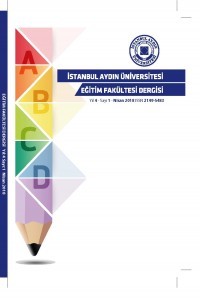Course Books and Technology Use in Language Teaching: Teachers’ Beliefs and Practices
beliefs, course book evaluation, technology adoption, language teaching
___
- Al-Hajailan, T., A. (1999). Evaluation of English as a foreign language textbook for thirdgrade secondary boys’ schools in Saudi Arabia. Doctoral dissertation, Mississippi State University, Mississippi. Askildson, V. (2008). What do teachers and students want from a foreign languagetextbook? Doctoral dissertation, University of Arizona, Arizona. Borg, S. (2003). Teacher cognition in language teaching: A review of research on what language teachers think,know, believe, and do. Language Teaching, 36, 81-109. Chen, F. H., Looi, C. K. & Chen, W. (2009). Integrating technology in the classroom: A visualconceptualization of teachers’ knowledge, goals and beliefs. Journal of Computer Assisted Learning, 25, 470-488. Kitchenham, A. (2006). Teachers and technology: A transformative journey. Journal of Transformative Education,4, 202-225. Lee, R. N. F. & Bathmaker A. (2007). The use of English textbooks for teaching English to’vocational’ students in Singapore secondary schools: A survey of teachers’ beliefs. RELC, 38, 350-374. Li, L. & Walsh, S. (2011). Technology uptake in Chinese EFL classes. Language TeachingResearch, (15). 99-125. Lin, S. (2011). Foreign Language Teaching in U.S. Higher Education Classrooms: An Investigation of the Relationship between Teacher Pedagogical Beliefs and Classroom Teaching. Doctoral dissertation, Portland State University, Oregon. Mundy, M., Kupczynski, L. & Kee, R. (2012). Teacher’s perceptions of technology use in theschools. SAGE Open, 2, 1-8. Qasem, R., F. (2010). The relationship between postsecondary foreign language teachers’ beliefs in student-centeredness and their educational technology practices. Doctoral dissertation, Northcentral University, Arizona. Russell, M., Bebell, D., O’Dwyer, L. & O’Connor, K. (2003). Examining teacher technologyuse: Implications for preservice and inservice teacher preparation. Journal of Teacher Education,54, 297-310. Straub, E. T., (2009). Understanding technology adoption: Theory and future directions for informal learning. Review of Educational Research, 79, 625-649. Woods, D. (1996). Teacher cognition in language teaching: beliefs, decision-making, and classroom practice.Cambridge Applied Linguistics series, Cambridge: Cambridge University Press. Woods Zacharias, N. (2005). Teachers’ beliefs about internationally-published materials: A survey oftertiary Englishteachers in Indonesia. RELC, 36(1), 23-37.
- ISSN: 2149-5483
- Yayın Aralığı: Yılda 2 Sayı
- Başlangıç: 2015
- Yayıncı: İstanbul Aydın Üniversitesi
Uluslararasılaşma – Ne kadar, Kime ve Sonuç?
Yükseköğretim Yönetici Görüşlerine Göre Yükseköğretimde Yeniden Yapılanma İhtiyacı
Course Books and Technology Use in Language Teaching: Teachers’ Beliefs and Practices
DİLER GÜLTEKİN, SELMA KARABINAR
Üniversitelerin Stratejik Planlarının Girişimci Üniversite Bağlamında İncelenmesi
KAHRAMAN ÇATI, Yusuf BİLGİN, Büşra KESİCİ, Önder KETHÜDA
Üniversite Öğrencilerinin Akıllı Telefon Kullanımlarının İncelenmesi
